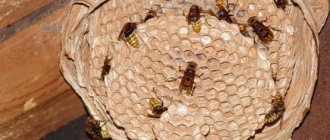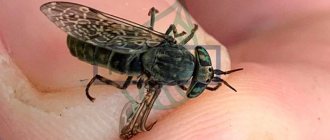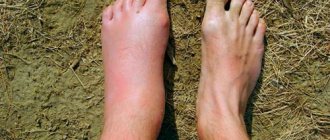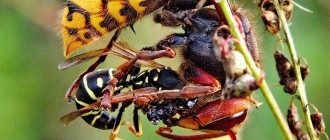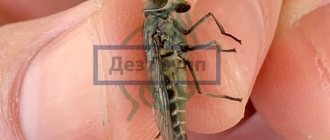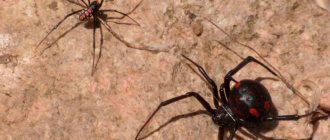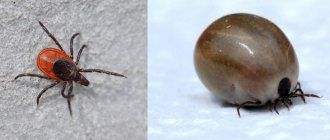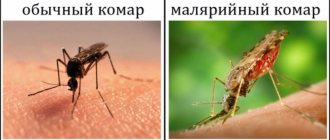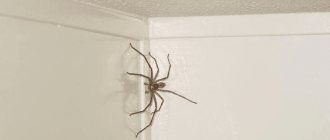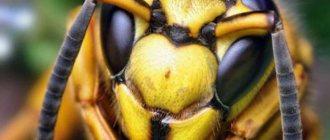An incredibly painful hornet sting will be remembered for a lifetime, but this is not the worst thing. It is life-threatening due to its toxic effects. To protect yourself and your loved ones from the consequences of an attack, it is important to learn the basic rules of first aid.
Unfortunately, few people know that the hornet is one of the most dangerous insects to humans. Unlike a bee, which stings only once, a hornet, like a wasp, can attack several times. And then, only adequate medical care can save the victim from death.
Who are hornets
What a hornet looks like and how painful its bite is is known to those who accidentally disturbed a wild insect in its shelter. The hornet is a hymenopteran predatory insect, the largest representative of the wasp family. The body length of an adult is from 2 to 2.5 cm, with the length of the uterus reaching 3.5 cm.
Unlike the thin wasp, the hornet has a more rounded abdomen and a larger crown of the head. Another important sign: brown-red color of the chest. In other representatives this part of the body is painted black. Basis of diet: flies, aphids, flower nectar or juice of various fruits. As a rule, stinging insects live in sun-warmed forest glades, gardens, and suburban areas.
Help: A hornet's nest can be found in any secluded place protected from bad weather: in a bush, in firewood, on a tree, under the roof of a house, on an open summer veranda. A swarm can contain up to 1 thousand individuals.
There are several dozen species of insects that live in different parts of our planet. The most common are: Japanese hornet, oriental, common, lamentable, Dybovsky, Asian.
Types of hornets and their lifestyle
Tireless builders construct cocoon-like nests from pieces of tree bark. Then the insects hang them in places protected from wind or rain: in attics, in the crown of trees, in a woodpile, etc. In such houses, the female lays eggs, and the remaining adults obtain food for the fast-growing offspring.
Since colonies of predators can be located in the most unexpected places, being outside the city, you need to be more careful. The hornets themselves are not aggressive and do not attack first. However, any sudden movement near the nest or its destruction signals danger and stimulates the production of an alarm pheromone, which determines the behavior of the entire swarm.
Asian hornet nest
Asian species are especially dangerous to humans, the bites of which are almost always fatal. The length of adult individuals reaches up to 5.5 cm, and the poison in the sting is highly toxic.
The bite of the European hornet, which lives on the territory of the Russian Federation, is more harmless and leads to the development of fatal complications only in the case of a rapid allergic reaction and the absence of timely anti-shock therapy.
Interesting fact: , from 70 to 100 people die from a hornet sting This fatality rate is much higher than the mortality rate from attacks by wild animals.
How and with what does a hornet bite?
The method of destruction cannot be called a bite, because the insect does not bite, but stings. Powerful, developed jaws are designed for obtaining food: small midges, arthropods. The expression “the hornet strikes” is not without meaning, because when approaching the victim, the insect does not sit on the surface of the skin, but sticks its sting with lightning speed, literally on the fly, bending in a special way. After injecting the poison, the hornet removes its sting.
The sting, designed to protect against attacks from enemies, is located at the bottom of the abdomen, and only in females. It does not have serrations, like bees, which means it is suitable for repeated attacks. If a person does not threaten the peace of a swarm or an individual, he is safe.
But in case of sudden movements, attempts to kill an insect or catch it, it will not only sting the offender, but will also send a signal to the rest of the inhabitants of the nest. The fact is that during the insertion of the sting, pheromones begin to be released, signaling danger. Having received the signal, a whole flock of hornets, capable of biting to death, flies to the aid of their relative.
Asian huge hornet on a man's hand.
It is impossible to avoid a hornet attack, because the insect, which has an unusually fast reaction, stings from any position. If a person's face is hidden by a mosquito net, the hornet sprays poison, leaving severe burns on the skin and mucous membranes.
What is the characteristic of a hornet bite?
It is almost impossible to die from one bite of a European hornet. However, the complex chemical composition of the poison entering the victim’s body causes a number of negative reactions. As a rule, the insect infects open areas of the body or face.
When the sting is inserted, the insect injects 0.5-2.0 mg of poison into the wound, causing an acute negative reaction in the victim’s body.
Note ! If you are bitten on the face, immediate help is especially important - toxic substances reduce visual function. The swelling quickly grows to the point where the eyes become impossible to open.
If the hand is injured, it is impossible to move your fingers. If there is a leg, the person is unable to walk due to pain.
The appearance of urticaria is a harbinger of Quincke's edema. Tumors that occupy large areas grow within an hour and do not subside within 10–48 hours. This complication is very dangerous, since swelling of the larynx makes breathing difficult and can lead to suffocation.
A hornet bite can be identified by the following signs:
- the bite site looks swollen, increasing several times, swells, turns red;
- the site of penetration of the sting is unbearably painful and itchy;
- heart rate increases;
- body temperature rises;
- dizzy;
- lymph nodes enlarge;
- inflamed ulcers form on the skin;
- blood pressure drops sharply.
If a person has a tendency to allergic reactions, the following are added to the above symptoms:
- nausea, sometimes vomiting;
- confusion of speech;
- hands and feet become cold;
- clouding of consciousness;
- in some cases, blueness of the neck, eyelids, lips, and ears is observed;
- soft tissues swell, attacks of suffocation appear;
Red rashes and peeling appear on the skin.
Folk remedies and recipes
Mallow
To alleviate the condition and relieve unpleasant symptoms in the bitten area, folk recipes that consist of applying to the damaged area also help well:
- a damp sugar cube, on which a wet towel is placed on top (the procedure is carried out for 10 minutes to draw out the poison, after which a compress is made with lemon juice);
- halves of onion or garlic clove;
- sour juices and solutions - squeezed lemon juice, vinegar (apple or table), half an apple, etc.;
- mashed leaves of medicinal plants: parsley, plantain, mallow, marigold.
To relieve edema and swelling, it is recommended to use compresses using the following solutions:
- Lemon: ½ tsp. citric acid per 150–200 ml of water, ½ cup of vinegar.
- Medicinal: ½ tsp. ammonia, ½ tsp. citric acid, 160–220 ml of vinegar or brandy.
Soak a handkerchief or cloth with the resulting solution and place it on the affected area. The compress should be changed 5-6 times until the swelling and redness subside.
Hornet venom and its effect on the body
The poisonous substance injected by the hornet under the skin of the victim is protective in nature, which explains the painfulness of the bite. The components that make up the poison are found in rattlesnakes and other representatives of the animal world. The most dangerous components include:
- Acetylcholine. Activates nerve endings. Once in the tissue, it leads to irritation of nerve nodes, the occurrence of impulses and severe pain in the affected area.
- Phospholipase A2. A combination of enzymes that destroy cell walls. This substance is similar to a component of snake venom. Leads to vascular damage, hemorrhage, and the formation of suppuration.
- Orientotoxin. Dissolves cell membranes, allowing their contents to exit into the intercellular space. Destroys cellular structures.
- Histamine. Activates a rapid allergic reaction.
- Mastoparan. Releases histamine.
- Mandorotoxin. Blocks the functions of the nervous system.
- Biogenic amines. They provoke disruptions in the functioning of the respiratory and cardiovascular systems. Cause arrhythmia and difficulty breathing.
The remaining components act as catalysts, enhancing the reaction of tissues, accelerating the process of distribution of toxic substances.
Actions to take if bitten at home
If you are bitten by a hornet, there is no need to panic, as this will only intensify the negative reaction of the body, which will immediately affect the condition of the victim. The most important thing is to stop the allergic reaction as soon as possible.
Severe symptoms of intoxication can greatly frighten the victim, especially a child. However, you should not lose your presence of mind. It is important to remember that timely and competent first aid will help to avoid the development of dangerous consequences of a bite.
First aid
When stung by a hornet, it is important to remember that the condition of the victim depends on how competently first aid was provided to him. Here are the main recommendations from experts:
- Help the victim move away from the site of the insect attack, sit him in a comfortable position, loosen tight-fitting clothing: belt, cuffs, collar.
- Inspect the site of the bite. If the hornet was killed during an attack, fragments of the sting may remain in the wound. They must be removed using tweezers treated with alcohol.
- Try to suck out the venom as soon as possible and then wash the bite area with cold water.
- Treat the affected area with a weak solution of potassium permanganate or other antibacterial agent.
- Wipe the bite area with an alcohol solution, eau de toilette or vodka.
- Apply a tight bandage just above the source to prevent the poison from spreading throughout the body. It is removed after 30 minutes.
- Apply an ice compress or just something cold.
- To prevent the development of an allergic reaction, give the victim an antihistamine.
- Provide the victim with plenty of drinking water, preferably non-carbonated mineral water.
- If an allergy does appear, take the victim to the nearest medical facility or call an ambulance.
When treating the bite site, you need to act very gently and delicately, barely touching the skin.
ethnoscience
When going out into nature, few people care about putting antihistamines or painkillers in the first aid kit. And then, to combat the consequences of a hornet bite, time-tested traditional medicine is used:
- A paste of fresh leaves of parsley, aloe or plantain will help relieve inflammation and slow down the spread of swelling.
- To relieve pain, apply a mixture of vinegar and dandelion juice to the bite site. A slurry made from crushed acetylsalicylic acid tablets, soda and water has a similar effect.
- A paste of fresh potatoes or cucumber will help relieve inflammation.
- To delay the hornet's venom at least a little, apply a damp piece of sugar to the bite site for 5-10 minutes.
Before using any folk remedy, the bite site must be thoroughly washed. After applying the product, cover the treated area with a clean natural cloth. Compresses need to be changed every 20 minutes.
Information for allergy sufferers
The hornet is especially dangerous for people with allergies, because the histamine contained in the insect's venom accelerates the development of an allergic reaction. Therefore, when leaving the confines of their home, people prone to allergic reactions should carry antihistamines and sorbents that accelerate the removal of toxins from the body.
It is also necessary to issue a special medical passport, which contains all the information about the drugs used and the effect of the body on them. And when going outdoors, it is important to inform your surroundings about a possible allergy to insect bites.
Medicines for allergic reactions:
- Citrine;
- Suprastin;
- Claritin;
- Erius;
- Loratadine;
- Fexofenadine.
External means:
- Fenistil-gel;
- Balm “Rescuer”;
- Psilo-balm.
To reduce the concentration of poison, sorbents are used:
- Polysorb;
- Smecta;
- White coal;
- Enterosgel.
First aid
When a hornet bites a person who has an individual allergic reaction to insect venoms, the likelihood of developing a state of shock increases. It is important to provide first aid to the victim in a timely manner:
- Place ice or cool with water on the damaged area.
- Lay the person down, which will help avoid possible loss of consciousness and collapse.
- If you feel weak and light-headed, lift the person’s legs up.
- Call an ambulance.
To save a person, visiting doctors use injections of antihistamines and other medications.
Why is a hornet sting dangerous for humans?
For a healthy person not predisposed to allergies, the maximum danger is posed by more than 20 bites at a time. Almost 96% of victims experience negative reactions from the body. For the remaining 4%, the hornet bite passes without consequences.
At risk:
- allergy sufferers who may develop severe allergic reactions leading to swelling of the larynx and death. However, such complications arise only when the victim does not receive qualified first aid;
- persons subjected to repeated insect attacks - the consequences will be more severe than the first time;
- a strong negative reaction is observed if the victim is a child with an unformed immune system;
- if the hornet stings the head, neck or the area where large vessels and arteries pass.
Consequences of a hornet sting
The body's reaction depends on the age and physical fitness of the victim, the presence of chronic pathologies, his predisposition to allergies and the number of bites.
If special first aid measures have not been taken, the danger lies in the development of the following consequences:
- infection and suppuration of the bite site;
- multiple hemorrhages, which is especially likely with multiple bites;
- local tissue necrosis;
- renal failure;
- heart failure;
- in case of individual intolerance to poison - anaphylactic shock;
- death.
Tips that may help
Most people don't even think that if they behave correctly when attacked by buzzing aggressors, they can avoid harm.
Here are some tips on what to do to avoid being bitten:
- If you are going to treat your area from the accumulation of dangerous insects, then do not forget to use personal protective equipment;
- If you find yourself in a place where there are a lot of buzzing “enemies,” behave quietly. There is no need to wave your arms or run. But if you decide that you need to escape, then run, but choose as your end point a place where it will be dark or where bushes and trees grow;
- Do not kill annoying wasps, hornets and others. By crushing the body of the “enemy” you will squeeze out a substance from it that will attract other individuals. The result of the murder is a swarm of angry insects;
- When planning to go on vacation, dress appropriately. Give preference to closed shoes and clothes in neutral colors. Don't use perfume that is too strong.
Now you know that a hornet bite is very dangerous for humans and can provoke dire consequences. Therefore, first aid in case of an insect attack should be provided immediately, do not take it lightly.
Preventing hornet bites
To protect yourself from attacks by poisonous insects, just follow the recommendations:
- When choosing a place for a picnic, first inspect the green spaces to identify insect nests.
- Avoid sudden movements when noticing stinging insects.
- If you find a nest, do not try to knock it down with a stick or destroy it.
- Do not knock on a tree or roof if you find a nest there.
- Stay away from that nest location.
- When going out of town, do not wear perfumes with floral or fruity scents.
